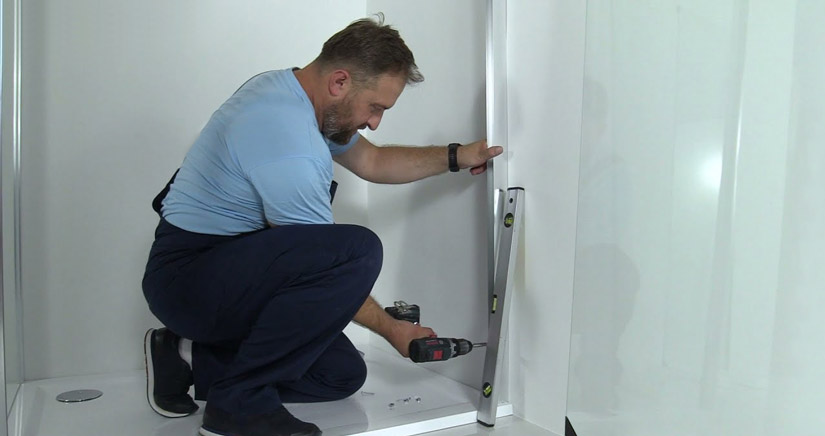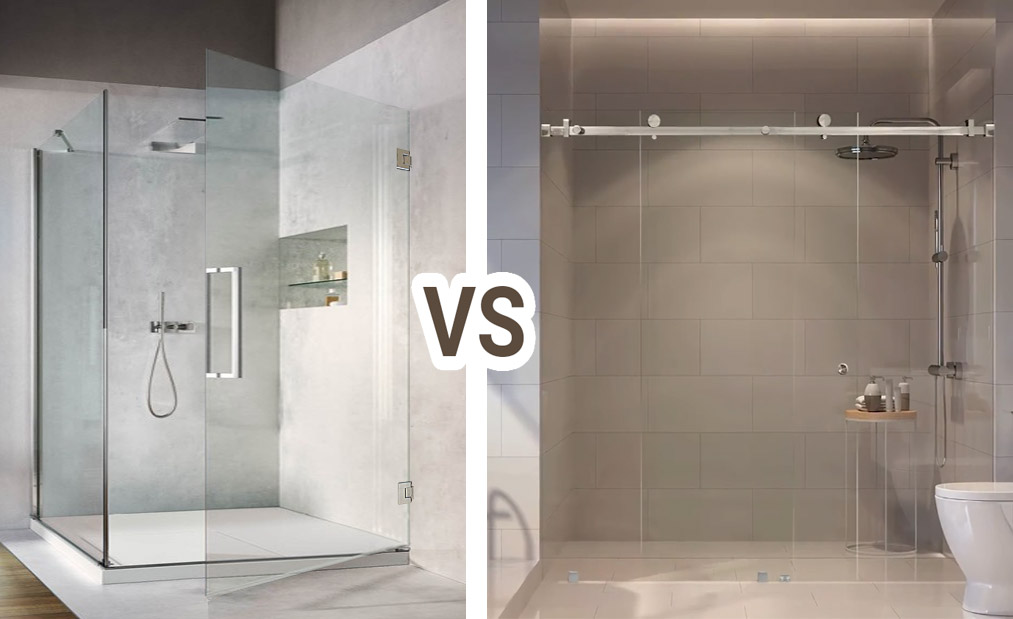
Hinged shower door vs. sliding shower – which is best? Answering this question is often a key aspect of your bathroom renovation. Once you’ve decided it’s time to update your bathroom with a new glass shower, lots of decisions remain including ones about door style and operation. We’ll take a look at the features and available options for both hinged and sliding shower doors and lay out the pros and cons of each.
1. What is a hinged shower door?
2. On what types of glass enclosures are hinged doors used?
3. What are the framing options for hinged doors?
4. What is a sliding shower door?
5. On what types of glass enclosures are sliding shower doors used?
6. What are the framing options for sliding doors?
7. What if I want frameless construction AND the space efficiency of sliding glass doors?
8. Are the same glass and hardware options available for hinged, rolling and sliding glass shower doors?
9. What are the pros and cons of hinged shower doors?
10. What are the pros and cons of rolling and sliding shower doors?
11. If I’m still not sure, how can I get personalized tips about which is best for my space?
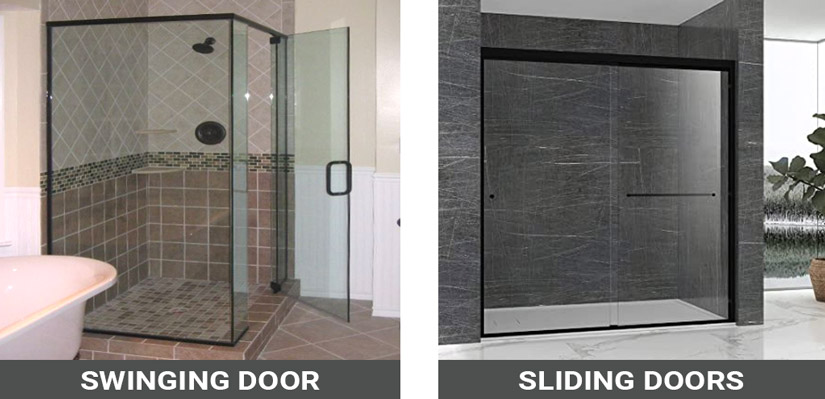
In order to choose wisely between a hinged shower door and a sliding one, it’s important to understand the products referred to by these terms. A hinged shower door is primarily composed of glass, and tempered or laminated glass is always used because annealed glass is too fragile for this application. The sheet of glass is attached to an adjacent surface with hinges so that it can swing out into the bathroom or both inward and outward. Two hinge options are offered:
If you’re unfamiliar with the pros and cons of each hinge type, the answers to these FAQS should be helpful.

What are the benefits of wall mounted hinges?

Wall mounted hinges offer a classic appearance that fits well in modern, traditional, transitional, and historic bathrooms. They also allow the swinging shower door to seal up when closed and don’t require a header for installation.

Are there any disadvantages to wall mounted hinges for a swinging shower door?

Wall mounted hinges are not as “low profile” as pivot hinges. This is only a drawback if you’re looking to minimize metal components on your shower door. You will also need to keep the glass clean around the hinges and keep soap scum or mineral deposits from building up there.

What are the benefits of pivot hinges for a swinging shower door?

Pivot hinges give a swinging shower door a more modern aspect. They are perfect for contemporary, modern, and transitional bathrooms. They are less noticeable than wall mounted hinges and make for simpler cleaning.

Are there any negatives to choosing pivot hinges?

Pivot hinges do not allow the door to seal up when closed. Also, since the upper hinge needs to be attached to something above it, a header may need to be installed on your shower.
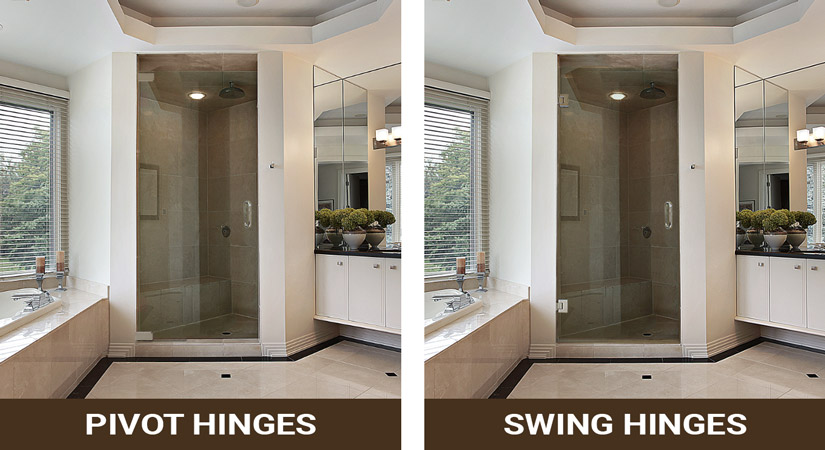
Hinged shower doors (also known as swinging shower doors) are used on a wide variety of shower enclosures.
Shower enclosures with hinged doors can be frameless, semi-frameless, or framed. Let’s take a closer look at the characteristics of each:
A hinged door shower enclosure can typically be frameless, semi-frameless, or framed. Frameless design is very popular because it does a great job keeping the shower tile visible. These enclosures also offer a modern, flowing look that keeps the focus on the glass. Finally, the simplicity and minimalism of a frameless shower enclosure makes cleaning easier. Semi-frameless enclosures give you a somewhat frameless look but at a lower cost. (This is because slightly thinner glass can be used on an enclosure that includes some framing.) Traditional framed doors are less popular but stand as an appealing option if you’re renovating on a budget.
However, a new type of framed swinging shower door has entered the market and now rivals the popularity of frameless designs. Known as Grid style shower doors, these have clear glass, a frame of black U-channel, and a black grid on the glass. The shower tile is visible through the clear glass though somewhat blocked by the gridwork. However, this black framing is often paired with white or other light colored tile for a pleasant contrast.

Instead of swinging open on hinges, a sliding glass shower door slides along tracking. These are referred to as bypass shower doors. Each unit includes two operable glass panels that can move past one another in parallel tracks. This offers a nice level of versatility by allowing you to enter or exit the shower on either side. At a glance, the characteristics of a bypass shower door system are:
There is also a Grid style sliding door system that is comprised of a single door panel which slides past a fixed panel beside it. This product brings together an in-vogue glass and metal combo as well as space-saving door operation.

As discussed above, many sliding shower doors come in pairs – two bypass doors in parallel tracks. Therefore, these are not used on shower stalls that call for a single door. You will see bypass doors on:

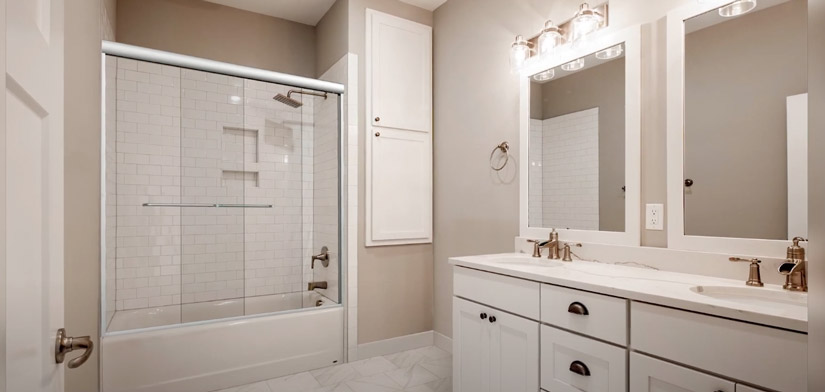
Sliding glass shower doors cannot be frameless because of the metal tracking necessary for their operation. Let’s take a closer look at the framing options that are available.
These three diverse options allow you to choose the sliding shower door most in line with your bathroom style. For instance, semi-frameless bypass doors fit in well with streamlined modern décor. Grid style glass works with many of today’s hottest home decorating modes, such as Japandi, Scandinavian, maximalism, and granny chic.
For some home decorators, none of the three options discussed above quite hits the mark. However, what option is available if limitations of space require sliding door operation but your design goals require frameless shower door construction? The answer is rolling shower doors. These are frameless shower doors that do not slide in metal tracks but roll along a header spanning the top of enclosure. This gives you the same space-efficiency as a sliding door but allows for the use of frameless glass. Let’s explore rolling “barn style” shower door options.
Like bypass doors, rolling doors can be used on bathtubs, showers, or custom glass enclosures.
In general, you can choose the glass style, hardware style, and hardware finish when working with a custom glass shop such as ABC Glass & Mirror. Many of the same options are available for hinged, rolling, and sliding doors. Some specific series have more limited choices in certain areas. For example, the hardware finishes available for rolling “barn style” shower doors are polished stainless, brushed stainless, oil rubbed bronze, and matte black, while a larger assortment is offered for hinged and bypass doors.
For most shower doors, though, you will be able to choose from these glass styles:

In terms of hardware, you can typically choose from a wide variety of door handles including small knobs, modern or classic handles, and handles that double as towel bars. Hinges have either beveled or square edges, and you can pick from various widths for the aluminum framing (if used).

Like all glass shower options, hinged shower doors provide a high-end alternative to a curtain. Understanding their specific pros and cons helps you make an informed purchase.

PRO: Swinging shower doors are a bit dressier than sliding doors and bring an upscale ambiance to your space.

PRO: Swinging shower doors can be customized through your choice of hinge type, glass style, handle style, hardware finish, and so on.

PRO: Hinged doors operate in a straightforward manner with few “moving parts,” which can minimize the need for repairs down the road.

CON: Building codes state that shower doors must be able to open out into the bathroom (even they’re hinged so that they can also swing into the stall). Therefore, sufficient empty space must be present around the shower entrance.

In the same way, rolling and sliding shower doors have unique sets of characteristics that make them more or less preferable for a certain bathroom. Let’s look at sliding doors first.

PRO: Sliding doors offer a streamlined modern look that harmonizes with many bathroom styles.

PRO: Sliding doors are space-friendly and require no clearance around the shower entrance.

PRO: Sliding doors can be customized in terms of glass style, handle style, hardware finish, framing thickness, etc.

CON: Sliding doors must be semi-frameless or framed, and these designs are not as popular as frameless.

CON: Doors that slide along tracks are a bit more intricate. This can make cleaning more time consuming, and there are more components that could potentially have issues down the road.
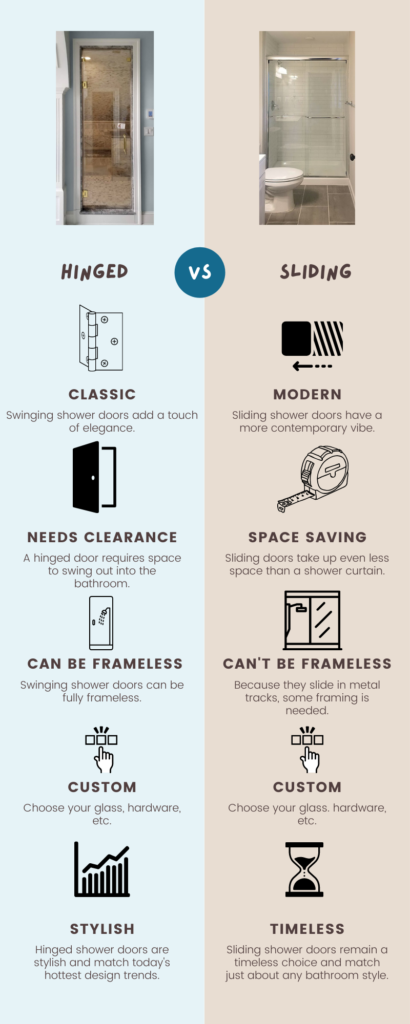
The nice thing about rolling “barn style” shower doors is that they combine many of the “pros” of the other two without some of the “cons.” These shower and tub enclosures bring together the stylishness of frameless glass and the space-efficiency of gliding door operation. Like sliding doors, they have a more involved operating system as compared to hinged doors. Also, their look is on the modern side which wouldn’t be the perfect fit for a period home or vintage style bathroom.
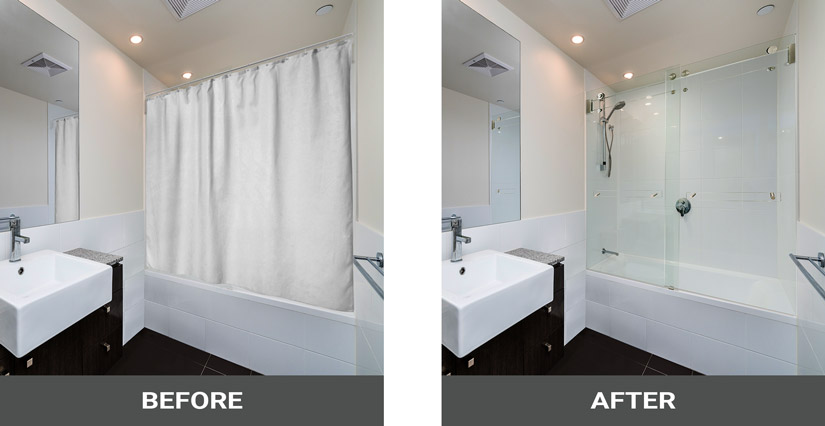
Still not sure which is best for your bathroom? You can set up a free, in-home meeting with an ABC Glass & Mirror shower door specialist. At this meeting, our estimator will inspect the shower area, record pertinent measurements and observations, show you product photos and samples, answer your questions, and provide tips and suggestions based on years of shower glass experience. With this further personalized info the choice between hinged, sliding, and rolling shower doors should be easier. The rest of the process of having a glass shower installed looks like this:
Contact ABC at (703)257-7150 to learn more and to set up your free appointment!
